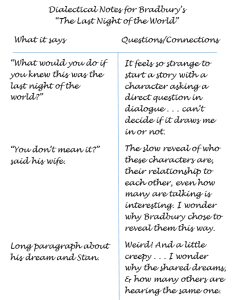Structure Analysis
Exploring the Structure of a Text
Exploring a text’s structure may sound a little complicated, but it really isn’t. We’re simply looking for how it’s been constructed or built, and then we’re thinking about how the structure supports the work the text is trying to do. The fancy literary terms for this are “form” and “function.” Form refers to the way the text is structured, while function refers to what it communicates to the reader.
Consider these questions when thinking about structure:
- How is the text organized? (Does it seem logical? Is it in time-related, chronological order? Does it skip around in time with flashbacks or flash-forwards?)
- Is it divided into obvious sections? Do the sections have headings, or are they just visually separated?
- Does the author use comparison/contrast, explore cause and effect, or examine a process to present their ideas?
- Is there a lot of detail and description in the text?
Does the author use dialog? - Does the author do anything unusual* or unexpected with the text?
Dialectic Note-taking
A dialectical approach to taking notes sounds much more complicated than it is. A dialectic is just a dialogue, a discussion between two (or more) voices trying to figure something out. Whenever we read new material, particularly material that is challenging in some way, it can be helpful to take dialectic notes to create clear spaces for organizing these different sets of thoughts.
Creating Dialectic Notes
Start by drawing a vertical line down the middle of a fresh sheet of paper to make two long columns.
The Left Column
This column will be a straightforward representation of the main ideas in the text you are reading (or viewing). In it, you will note things like
- What are the author’s main points in this section?
- What kind of support is the author using in this section?
- Other points of significant interest?
- Note the source and page number, if any, so that you can find and document this source later
You candirectly quote these points, but do write them down as you encounter them, not after the fact. If you quote directly, use quotation marks; if you paraphrase, do not use quotation marks. Be consistent so that you don’t make more work for yourself when you start writing your draft.
The Right Column
The right column will be the questions and connections you make as you encounter this author’s ideas. This might include
- Questions you want to ask in class
- Bigger-picture questions you might explore further in writing
- Connections to other texts you’ve read or viewed for this class
- Connections to your own personal experiences
- Connections to the world around you (issues in your community, stories on the news, or texts you’ve read or viewed outside of this class)
Bottom of the Page
It is often a good idea to leave space at the bottom of the page (or on the back) for additional notes about this piece you may want to write down based on what your instructor has to say about it or for comments and questions your peers make about it during class discussion.
Example
Once you’ve finished the text and have taken your dialectic notes while reading it, you might have something that looks a bit like this (for the sake of the example, I read a story I’d never read before from an author I’m familiar with, so you could see genuine reactions to a first read):

Once you have this set of dialectic notes, there are a number of ways you can use them. Here are a few:
- They can help you contribute to class discussion about this piece and the topics it addresses.
- Significant questions you encountered while reading are already written down and collected in one place so you don’t have to sift back through the reading to re-discover those questions.
- These notes provide a place where many of your observations and thoughts about the piece are already organized, which can help you see patterns and connections within those observations. Finding these connections can be a strong starting point for written assignments.
- If you are asked to respond to this piece in writing, these notes can serve as a reference point as you develop a draft. They can give you new ideas if you get stuck and help keep the original connections you saw when reading fresh in your mind as you respond more formally to that reading.

